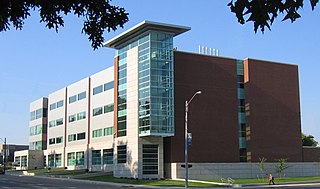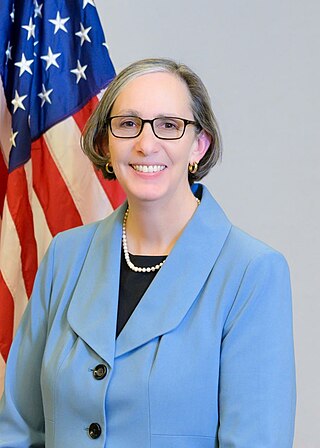
The University of Tennessee Health Science Center (UTHSC) is a public medical school in Memphis, Tennessee. It includes the Colleges of Health Professions, Dentistry, Graduate Health Sciences, Medicine, Nursing, and Pharmacy. Since 1911, the University of Tennessee Health Science Center has educated nearly 57,000 health care professionals. As of 2010, U.S. News & World Report ranked the College of Pharmacy 17th among American pharmacy schools.
The Vanderbilt University Medical Center (VUMC) is a medical provider with multiple hospitals in Nashville, Tennessee, as well as clinics and facilities throughout Middle Tennessee. VUMC is an independent non-profit organization, but maintains academic affiliations with Vanderbilt University. As of 2022, the health system had more than 3 million patient visits a year, a workforce of 40,000, and 1,709 licensed hospital beds.
The Duke University School of Medicine, commonly known as Duke Med, is the medical school of Duke University. It is located in the Collegiate Gothic-style West Campus of Duke University in Durham, North Carolina. The School of Medicine, along with the Duke University School of Nursing, Duke University Hospital, Duke Regional Hospital, Duke Children's Hospital, Duke Raleigh Hospital, and other affiliated hospitals, clinics, and laboratories, make up the Duke University Health System. Established in 1925 by James B. Duke, the School of Medicine has earned its reputation as an integral part of one of the world's foremost patient care and biomedical research institutions.

The Joan & Sanford I. Weill Medical College of Cornell University is Cornell University's biomedical research unit and medical school in New York City.
Southern Illinois University School of Medicine is a medical school located in Springfield, the capital of the U.S. state of Illinois. It is part of the Southern Illinois University system, which includes a campus in Edwardsville as well as the flagship in Carbondale. The medical school was founded in 1970 and achieved full accreditation in 1972. It was founded to relieve a chronic shortage of physicians in downstate Illinois.

The Lewis Katz School of Medicine at Temple University (LKSOM), located on the Health Science Campus of Temple University in Philadelphia, Pennsylvania. It is one of seven schools of medicine in Pennsylvania that confers the Doctor of Medicine degree. It also confers Ph.D and M.S. degrees in biomedical science, and offers a Narrative Medicine program.
Jeffrey R. Balser is the president and CEO of Vanderbilt University Medical Center (VUMC) and dean of the Vanderbilt University School of Medicine (VUSM). Balser is a 1990 graduate of the Vanderbilt M.D./Ph.D. program in pharmacology and subsequently completed residency training in anesthesiology and fellowship training in critical care medicine at Johns Hopkins. He continued to work at Johns Hopkins as a cardiac anesthesiologist and ICU physician before returning to Vanderbilt University and joining VUMC in 1998. Balser was appointed dean of the VUSM in 2008 and, the following year, was appointed the vice chancellor for health affairs at Vanderbilt, in charge of the medical center. He became president and CEO of VUMC in 2016 when the medical center became a financially distinct non-profit organization.
Mildred T. Stahlman is an American neonatologist and academic. She worked as a professor of pediatrics and pathology at Vanderbilt University in Nashville, Tennessee.

Monroe Carell Jr. Children's Hospital at Vanderbilt, also known as Children's Hospital at Vanderbilt, is a nationally ranked pediatric acute care children's teaching hospital and entity of Vanderbilt University Medical Center in Nashville, Tennessee. The hospital is affiliated with Vanderbilt University School of Medicine's Department of Pediatrics.
The University of Tennessee College of Medicine is one of six graduate schools of the University of Tennessee Health Science Center (UTHSC) in downtown Memphis. The oldest public medical school in Tennessee, the UT College of Medicine is a LCME-accredited member of the Association of American Medical Colleges (AAMC) and awards graduates of the four-year program Doctor of Medicine (MD) degrees. The college's primary focus is to provide practicing health professionals for the state of Tennessee.
David Charles is an American neurologist, professor and vice-chair of neurology, and the medical director of Telehealth at Vanderbilt University Medical Center.

Consuelo H. Wilkins is an American physician, biomedical researcher, and health equity expert. She is Senior Vice President and Senior Associate Dean for Health Equity and Inclusive Excellence at Vanderbilt University Medical Center. She is a professor of medicine in the Department of Medicine, Division of Geriatrics at Vanderbilt University School of Medicine and has a joint appointment at Meharry Medical College. She additionally serves as one of the principal investigators of the Vanderbilt Clinical and Translational Science Award, Director of the Meharry-Vanderbilt Community Engaged Research Core (CTSA) and as vice president for Health Equity at Vanderbilt University Medical Center.
Alice Drew Chenoweth (1903–1998) was an American physician who specialized in pediatrics and public health, and served as the Chief of the Division of Health Services in the United States Children's Bureau.

Thomas L. Maddin (1826–1908) was an American physician. He treated black slaves in Alabama in the antebellum era. He served as the director of a hospital for the Confederate States Army in Nashville, Tennessee, during the American Civil War. He was a professor of medicine at the University of Nashville and the Vanderbilt University School of Medicine.
Grant Winder Liddle was an American endocrinologist whose research focused largely on the hypothalamic–pituitary–adrenal axis. He was a professor at Vanderbilt University and chaired its Department of Medicine from 1968 to 1983.

Marshall L. Summar is an American physician, clinical geneticist and academic specializing in the field of genetics and rare disease. He is board-certified in pediatrics, biochemical genetics and clinical genetics. He is best known for his work in caring for children with rare genetic diseases.

Manish Kumar Sethi is an American physician and former political candidate. He is the president and founder of the non-profit Healthy Tennessee and an orthopedic trauma surgeon at Vanderbilt University Medical Center. Sethi serves as the Director of the Vanderbilt Orthopedic Institute Center for Health Policy and is the lead author of the books An Introduction to Health Policy and Orthopedic Traumatology: An Evidence Based Approach.

Barney S. Graham is an American immunologist, virologist, and clinical trials physician.

W. Kimryn Rathmell is an American physician-scientist whose work focuses on the research and treatment of patients with kidney cancers. She is the Hugh Jackson Morgan Professor and Chair of the Department of Medicine at Vanderbilt University Medical Center (VUMC), and Physician-in-Chief for Vanderbilt University Adult Hospital and Clinics in Nashville, Tennessee. On Nov. 17, 2023, Rathmell was announced as the next Director of the National Cancer Institute.
Harry R. Jacobson is an American physician executive and entrepreneur who served as the vice chancellor for health affairs and CEO of Vanderbilt University Medical Center from 1997 to 2009.













